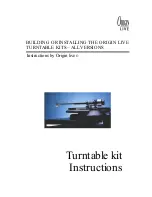
15
when the tops of the plastic housings are absolutely level with the top edge of the plinth.
Drill the holes for the hinge screws in the plinth using a 3mm or 3.5mm drill. -. The two hinge housings can now be
screwed into position on the plinth – Re-insert the lid hinges to check the fit of the lid.
Pull the lid off the turntable to allow you to build the rest of kit – you can re-fit the lid once the deck is complete.
Fit the switch and dc regulator board to the plinth.
Cut the switch shaft so that 10mm is left of it’s smooth portion - use a hacksaw or powerful pair of wire snips. Remove
the serrated washer from the switch and do not use it at all. The switch can then be fitted in position in the pre-drilled
hole at the front left hand side of the plinth. You need only tighten the top clamping nut to the point that the switch
body won’t rotate when the shaft is clicked through it’s 3 positions. Be careful not to cross-thread the nut when you put
it on.
Fit the knob and tighten up the set screw in it’s side to clamp it onto the switch shaft. A 2mm allen key is provided to
tighten this set screw.
If you have the
advanced
dc regulator board then position it on the left underside of the plinth top-board (close to the
walls of the plinth front corner). Mark the position of the centre hole in the board onto the underside of the plinth top-
board – drill a shallow 3mm dia hole and screw the board into position with a No 6 x ½” screw. See diagram “Top view
of wiring layout & connections” for position.
If you have the
standard
dc reguator board then position it on the left underside of the plinth topboard (close to the
walls of the plinth front corner). Mark the position onto the underside of the plinth topboard for holes right on the edge
of 2 opposite sides of the strip board– drill these shallow holes using a 3mm dia drill and screw the board into position
with two No 6 x ½” screws and the brass washers such that the washers catch on the edge of the board and hold it on.
See diagram “Top view of wiring layout & connections” for position.
Top view of wiring layout & connections
Please read the following section before handling the dc regulator board
The boards are always tested and working when they leave Origin live however there is a failure rate that occurs at the
point of installation and which we replace freely. Some of the components on the dc regulator board are highly
sensitive to static discharge - so please observe the following - once the board is installed it is extremely reliable but
installing does need care or the board may not work. The reason for this is that your clothing can generate well over
5000 Volts just by moving - this voltage is then discharged to whatever you touch.
When picking up the board always touch the surface it is standing on first before touching the board or any associated
wires etc. This way you are then “earthed to the same potential as the board.
When holding the board and placing it anywhere, always touch the work top with one hand as you place the board onto
it. The same principle should be applied for all other movements of the board - e.g. when you install it to the turntable
always touch the turntable as you touch the board down into it.
Lastly be careful not to allow the output red and black wires to contact one another - especially after power has been
applied to the circuit.
If you need to remove the board at any stage switch off the power supply first.
Lastly - it is unlikely that you will damage your board even if you ignore the precautions above - one thing you
can be certain of is that if the board works correctly via the switch and speed control the performance is fine
and it is not damaged.














































